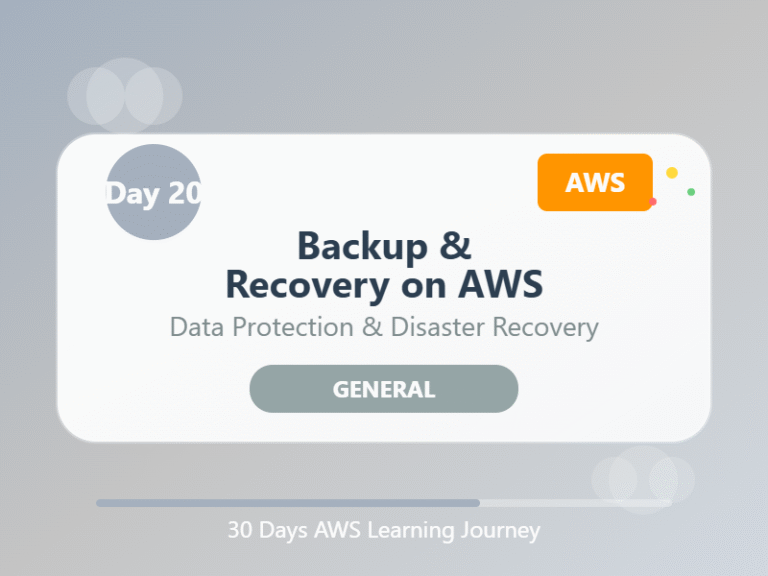🛡️ Day 20: Backup & Recovery on AWS
Category: AWS Storage & Management
Goal: Learn how to protect your data in the cloud and recover it when needed.
🧠 What You’ll Learn Today:
- What backup and recovery mean in cloud
- Native AWS services for backup
- Backup strategies
- Disaster Recovery (DR) basics
🔁 1. What is Backup & Recovery?
- Backup: Making a safe copy of your data to use in case of loss.
- Recovery: Restoring data after accidental deletion, system failure, or disaster.
In AWS, you don’t just back up your laptop — you back up cloud resources like EC2, RDS, EFS, S3, etc.
🧰 2. Tools AWS Offers for Backup
✅ AWS Backup
- Centralized backup service
- Automatically backs up EC2, RDS, DynamoDB, EFS, etc.
- Set backup schedules and retention policies
✅ Amazon S3 Versioning
- Keeps old versions of your files
- Restore if accidentally overwritten or deleted
✅ EBS Snapshots
- Point-in-time backups of your EC2 volume
- Easily restore to a new instance
✅ RDS Automated Backups
- Daily snapshots + transaction logs
- Recovery to any point in time within retention period
🗂️ 3. Backup Best Practices
- Automate backups using AWS Backup
- Use S3 versioning for important files
- Store critical backups in multiple regions
- Set retention rules to manage cost
- Test recovery regularly!
🌪️ 4. What is Disaster Recovery (DR)?
Disaster Recovery is the plan to keep services running (or recover them) after major issues like:
- Region failures
- Data corruption
- Cyber attacks
Common DR Strategies:
| DR Type | Recovery Time | Cost | Notes |
|---|---|---|---|
| Backup & Restore | Hours | Low | Cheapest option |
| Pilot Light | Minutes-Hours | Medium | Core services running |
| Warm Standby | Minutes | Higher | Scaled-down copy |
| Multi-Site (Hot) | Seconds | High | Full duplicate live system |
🧠 End of the Day Notes:
🔐 Backups are your safety net in the cloud.
💡 Recovery is not just about copying — it’s about how fast and how complete the restore is.
📦 Always think about what you need to back up and how quickly you need it back.
🔁 Navigate the Series:
⬅️Day 19: S3 vs EBS vs EFS – AWS Storage Services Compared
➡️Day 21: S3 Lifecycle Policies – Automate Data Management in AWS


